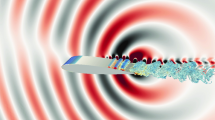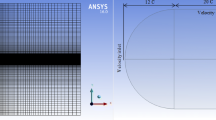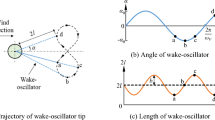Abstract
The present paper evaluates two unsteady transition modelling approaches: the prescribed unsteady intermittency method PUIM, developed at Cambridge University and the dynamic unsteady intermittency method developed at Ghent University. The methods are validated against experimental data for the N3-60 steam turbine stator profile for steady and for unsteady inlet flow conditions. The characteristic features of the test case are moderately high Reynolds number and high inlet turbulence intensity, which causes bypass transition. The tested models rely both on the intermittency parameter and are unsteady approaches. In the prescribed method, the time-dependent intermittency distribution is obtained from integral relations. In the dynamic method, the intermittency distribution follows from time-dependent differential equations. For unsteady computations, self-similar wake profiles are prescribed at the inlet of the computational domain. Joint validation of the prescribed and the dynamic unsteady intermittency models against experimental data shows that both methods are able to reproduce the global features of the periodical evolution of the boundary layer under the influence of a periodically impinging wake. The overall quality of the dynamic method is better than that of the prescribed method.
Similar content being viewed by others
References
Zarzycki, R., Elsner, W.: The effect of wake parameters on the transitional boundary layer on a turbine blade. IMechE Part A. J. Power Energy 219, 471–480 (2005)
Watanabe, E., Tanaka, Y., Nakano, T., Ohyama, H., Tanaka, K., Miyawaki, T., Tsutsumi, M., Shinohara, T.: Development of a new high efficiency steam turbine, Mitsubishi Heavy Industries Ltd. Tech. Rev. 40, (4), 1–6 (2003)
Cardamone, P., Martinstetter, M., Pfitzner, M., Lötzerich, M.: Aerodynamic Optimisation of HP turbine cascade blades for heavy duty gas turbine applications, Part 1: Experimental Investigations, Proc. of 17th International Symposium on Airbreathing Engines—ISABE, Munich 2005
Jacobs, R.G., Durbin, P.A.: Simulations of bypass transition. J. Fluid Mech. 428, 185–212 (2001)
Elsner, W.: Influence of nonstationary interactions on laminar-turbulent transition process on a turbine blade profile. CzUT Publishing, Ser. Monographs, vol.103, Czestochowa (2004)
Addison, J.S., Hodson, H.P.: Modeling of unsteady transition boundary layers. ASME J. Turbomach. 114, 580–589 (1992)
Schulte, V., Hodson, H.P.: Prediction of the becalmed region for LP turbine profile design. ASME J. Turbomach. 120, 839–846 (1998)
Ramesh, O.N., Hodson, H.P.: A new intermittency model for incorporating the calming effect. Proc. of 3th European Turbomachinery Conference, IMechE, Cambridge University Press, 243–258 (1999)
Vilmin, S., Savill, M.A., Hodson, H.P., Dawes, W.N.: Predicting wake–passing transition in turbomachinery using an intermittency-conditioned modelling approach. 33rd AIAA Fluid Dynamics Conference and Exhibit, Orlando, Paper AIAA-2003-3995 (2003)
Lodefier, K., Merci, B., De Langhe, C, Dick, E.: Intermittency based RANS bypass transition modelling. Prog. Comput. Fluid Dyn. 6, 68–78 (2006)
Lodefier, K., Dick, E.: Modelling of unsteady transition in low-pressure turbine blade flows with two dynamic intermittency equations. Flow Turbul. Combust. 76, 103–132 (2006)
Suzen, Y.B., Huang, P.G., Hultgren, L.S., Ashpis, D.E.: Predictions of separated and transitional boundary layers under low-pressure turbine airfoil conditions using an intermittency transport equation. ASME J. Turbomach. 125, 455–464 (2003)
Suzen, Y.B., Huang, P.G.: Numerical simulation of unsteady wake/blade interactions in low-pressure turbine flows using an intermittency transport equation. ASME J. Turbomach. 127, 431–444 (2005)
Menter, F.R., Langtry, R., Völker, S.: Transition modelling for general purpose CFD codes. Flow Turbul. Combust. 77, 277–303 (2006)
Menter, F.R., Langtry, R.B., Likki, S.R., Suzen, Y.B., Huang, P.G., Völker, S.: A correlation-based transition model using local variables—Part I: model formulation, Part 2: test cases and industrial applications. ASME J. Turbomach. 128, 413–434 (2006)
Vicedo, J., Vilmin, S., Dawes, W.N., Savill, A.M.: Intermittency transport modelling of separated flow transition. ASME J. Turbomach. 126, 424–431 (2004)
Data Base of Transition Modeling Test Cases (TC4D000); web page: http://ercoftac.mech.surrey.ac.uk/
Elsner, W., Vilmin, S., Drobniak, S., Piotrowski, W.: Experimental analysis and prediction of wake-induced transition in turbomachinery. ASME Turbo Conference and Exhibit 2004, Vienna, Paper GT2004–53757 (2004)
Lodefier, K., Dick, E., Piotrowski, W., Elsner, W.: Modelling of wake-induced transition with dynamic description of intermittency. Proc. of 6th European Turbomachinery Conference, Lille, 730–739 (2005)
Gostelow, J.P., Blunden, A.R., Walker, G.J.: Effects of free-stream turbulence and adverse pressure gradients on boundary layer transition. ASME J. Turbomach. 116, 392–404 (1994)
Solomon, W.J., Walker, G.J., Gostelow, J.P.: Transition length prediction for flows with rapidly changing pressure gradients. ASME J. Turbomach. 118, 744–751 (1996)
Mayle, R.E.: The role of laminar-turbulent transition in gas turbine engines. ASME J. Turbomach. 113, 509–537 (1991)
Abu-Ghannam, B.J., Shaw, R.: Natural transition of boundary layers—the effects of turbulence, pressure gradient and flow history. J. Mech. Eng. Sci. 22, 213–228 (1980)
Drela, M., Giles, M.B.: Viscous-inviscid analysis of transonic and low Reynolds number airfoils. AIAA J. 25, 1347–1355 (1987)
Yang, Z., Shih, T.H.: New time scale based k–ε model for near-wall turbulence. AIAA J. 31, 1191–1198 (1993)
Menter, F.R.: two-equation eddy-viscosit turbulence models for engineering applications. AIAA J. 32, 1598–1605 (1994)
Medic, G., Durbin, P.A.: Toward improved prediction of heat transfer on turbine blades. ASME J. Turbomach. 124, 187–192 (2002)
Cho, R., Chung, M.K.: A k–ε–γ equation turbulence model. J. Fluid Mech. 237, 301–322 (1992)
Steelant, J., Dick, E.: Modelling of laminar-turbulent transition for high free-stream turbulence. J. Fluids Eng. 123, 22–30 (2001)
Lardeau, S., Leschziner, M.A.: Unsteady RANS modelling of wake-blade interaction: computational requirements and limitations. Comput. Fluids 34, 3–21 (2005)
Author information
Authors and Affiliations
Corresponding author
Rights and permissions
About this article
Cite this article
Piotrowski, W., Lodefier, K., Kubacki, S. et al. Comparison of Two Unsteady Intermittency Models for Bypass Transition Prediction on a Turbine Blade Profile. Flow Turbulence Combust 81, 369–394 (2008). https://doi.org/10.1007/s10494-008-9136-4
Received:
Accepted:
Published:
Issue Date:
DOI: https://doi.org/10.1007/s10494-008-9136-4




